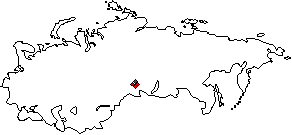CONTENTS
IntroductionForeword
Language Groups
Tribes and Dialects
Order the book
The Peoples
of the Red Book
Abazians (Abaza)Abkhaz
Aguls
Akhvakhs
Aleuts
Altaics
Aliutors
Andis
Archis
Asiatic Eskimos
Bagulals
Baraba Tatars
Bartangs
Bats
Bezhtas
Botlikhs
Budukhs
Central Asian Jews
Chamalals
Chukchis
Chulym Tatars
Crimean Jews
Crimean Tatars
Didos
Dolgans
Enets
Evens
Evenks
Georgian Jews
Godoberis
Hinukhs
Hunzibs
Ingrians
Ishkashmis
Itelmens
Izhorians
Kamas
Karaims
Karatas
Karelians
Kereks
Kets
Khakass
Khants
Khinalugs
Khufis
Khvarshis
Kola Lapps
Koryaks
Kryz
Kurds
Lithuanian Tatars
Livonians
Mansis
Mountain Jews
Nanais
Negidals
Nenets
Nganasans
Nivkhs
Nogays
Orochis
Oroks
Oroshoris
Peoples of the Pamirs
Roshanis
Rutuls
Selkups
Shors
Shughnis
Tabasarans
Talysh
Tats (Tatians)
Tindis
Tofalars
Trukhmens (Turkhmens)
Tsakhurs
Udeghes
Udis
Ulchis
Veps
Votes
Wakhs
Yaghnabis
Yazgulamis
Yukaghirs
visit the guestbook or mail comments to the webmaster

THE KAMAS
Habitat. This minor ethnic group lives on the Upper Mana and Kan rivers in the district of Krasnoyarsk, Southern Siberia.
Population. According to 1969 census data there were about 200 Kamas (N. Baskakov).
Origin. The southern Samoyedic peoples who lived in the Sayan Mountains and Southern Siberia, for example, the Karagas, Koibal, and Kamas, turkicized in the 18th--19th centuries. The Samoyed-speaking Kamas people lived on the Upper Kan river. They used the name kalmazh or kangmadzh to indicate themselves; Castrén's designation was kagmashe. Part of the Kamas people became russified while the other part were turkicized. In the 1920s some old people still remembered their old "Taiga" language.
Language. The surviving Kamas language belongs to the Uighur-Tüküi group of the Turkic languages, related to Khakass and, in particular, to its Kyzyl dialect. Characteristically, there is a strong Samoyedic substratum.
Writing. The Kamas do not have a written language, instead they employ Russian.
REFERENCES
- А. Баскаков, Введение в изучение тюркских языков, Москва 1969
LV